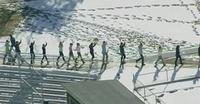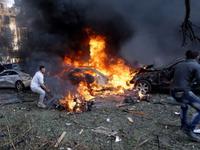-
16-year old Seattle girl escapes injury: her glasses deflect bullet
A 16-year old girl escaped potentially life-threatening injury when the glasses she was wearing deflected a bullet fired from a car toward her Seattle home, the Seattle police said. The girl was asleep on her living room couch, with her glasses on, near 10:00 p.m. on Saturday when several shots were fired at the house from a dark-colored sedan. Most of the bullets went through the walls of the house, but one of them went through the front window, striking the bridge of the teen’s glasses. The girl suffered only minor injuries.
-
-
Elbit Systems’ subsidiary to provide secure broadband mobile solution for first responders
DHS Science & Technology Directorate (S&T) has selected Elbit Systems of America, a wholly owned subsidiary of Elbit Systems, to provide a technology demonstrator for a secure broadband services solution for first responders. DHS will use this solution to test the new LTE broadband network with various mission critical secure multimedia services for public safety users. Following the integration and proof of concept phase, DHS will proceed with field tests within selected homeland security components.
-
-
Not all questions about the Tsarnaev brothers have been answered

What caused Tamerlan and Dzhokhar Tsarnaev to plant two bombs at the Boston Marathon finish line continues to puzzle investigators. Understanding the information which was available to local and federal law enforcement authorities before and after the attack might help prevent a future attack.
-
-
U.S. nuclear weapon programs to cost $355 billion over a decade: CBO
In its most recent review of U.S. nuclear policy, the Obama administration decided to maintain all three types of systems that can deliver nuclear weapons over long ranges — submarines that launch ballistic missiles (SSBNs), land-based intercontinental ballistic missiles (ICBMs), and long-range bombers — known collectively as the strategic nuclear triad. The administration also decided to preserve the ability to deploy U.S. tactical nuclear weapons carried by fighter aircraft overseas in support of allies. Nearly all of these delivery systems and the nuclear weapons they carry are nearing the end of their planned operational lives and will need to be modernized or replaced by new systems over the next two decades. The Congressional Budget Office (CBO) estimates that between 2014 and 2023, the costs of the administration’s plans for nuclear forces will total $355 billion.
-
-
Wearable body-cameras adopted by more police departments
Law enforcement agencies around the country are testing body-cameras on officers as a way to keep records of police interaction with the public. The cameras may be attached to hats, eyeglasses, or hung around the neck, giving the public and the courts a more intimate look at how police do their jobs.
-
-
Maine police uses social media, sponsored apps to fight crime
The accessibility of smartphones and the popularity of apps are making it easier for police to share and receive information from the public. Law enforcement agencies in Maine are using department-managed social media pages to engage with the public. Police department in money also use funds from recovered items and cash seized from drug busts to fund the development of apps which make it easier for the public to communicate with the police and report crimes.
-
-
Measures being offered to reduce mass shootings not likely to succeed

Criminologists debunk eleven common myths which dominate the discussion about how to put an end to, or at least reduce, the number and scope of mass shooting. They argue that the measures typically offered to deal with the problem — widening the availability of mental-health services, enhanced background checks, having armed guards at schools, censoring violent entertainment, especially video games, and more – would, at best, merely take a nibble out of the risk of mass murder. Even reducing mass shooting marginally would be a worthy goal, but “eliminating the risk of mass murder would involve extreme steps that we are unable or unwilling to take — abolishing the Second Amendment, achieving full employment, restoring our sense of community, and rounding up anyone who looks or acts at all suspicious. Mass murder just may be a price we must pay for living in a society where personal freedom is so highly valued,” they write.
-
-
U.S. Air Force plans to add 1,000 new cybersecurity personnel
Budget cuts notwithstanding, the U.S. Air Force plans to add 1,000 new personnel between 2014 and 2016 as part of its cybersecurity units. The 24th Air Force at Joint Base San Antonio-Lackland, Texas is home to the U.S. Air Force cyber command. With a budget of about $1 billion and a staff of roughly 400 military and civilian personnel, the command oversees about 6,000 cyber defense personnel throughout the Air Force.
-
-
Review panel calls for prohibiting NSA bulk collection of phone metadata
A 300-page report prepared for President Barack Obama made forty-six recommendations for better management of, and different guiding rules for, U.S. surveillance programs. Among the report’s recommendations: The NSA should be banned from attempting to undermine the security of the Internet and prohibited from collecting telephone records in bulk; spying on foreign leaders should require an authorization from a higher level then is currently the case; the government should be banned from undermining encryption. The president will announce by 28 January which of the forty-six recommendations he would accept.
-
-
Sandia to show Mine Rescue Robot at 2013 DARPA Robotics Challenge
Engineers from Sandia National Laboratories will demonstrate real-world robotics successes at the DARPA Robotics Challenge Trials 2013 Expo this week (20-21 December) in Florida. The challenge is focused on human-scaled robots that assist in humanitarian aid and disaster response. Sandia engineers will demonstrate the Gemini Scout Mine Rescue Robot, which was designed to overcome dangers lurking in a mining accident: poisonous gases, flooded tunnels, explosive vapors, and unstable walls and roofs. Such potentially deadly conditions and unknown obstacles can slow rescue efforts to a frustrating pace.
-
-
Federal judge: NSA's collection program violates Constitution

A federal judge, describing the NSA metadata collection program as “almost Orwellian,” yesterday ruled that the program which systematically collects and keeps records of all Americans’ phone calls most likely violates the Constitution. “I cannot imagine a more ‘indiscriminate’ and ‘arbitrary’ invasion than this systematic and high-tech collection and retention of personal data on virtually every single citizen for purposes of querying and analyzing it without prior judicial approval,” Judge Richard J. Leon wrote. “Surely, such a program infringes on ‘that degree of privacy’ that the founders enshrined in the Fourth Amendment.”
-
-
Guards at U.K. nuclear weapons facility slept on the job, skipped routine patrols
Police officers of the U.K. Ministry of Defense police, assigned to guard Britain’s nuclear weapons, are under investigation after it has been reported that they had slept on the job and failed to complete routine patrols at a nuclear weapons facility. The Atomic Weapons Establishment (AWE) in Burghfield, Berkshire, is the location of the complex final assembly of nuclear weapons, and also where the U.K. nuclear warheads are maintained and decommissioned.
-
-
Boston Police has suspended use of license plate scanners
TheBoston Police Department (BPD) has suspended its use of license plate scanners which enable law enforcement agencies automatically to scan vehicles for traffic or criminal violations. The announcement comes after an investigation raised privacy concerns regarding whether BPD is capable of securing the data collected from the license plate scanners. The investigation also revealed that information on wanted vehicles captured by the scanners was not followed.
-
-
Shot spotting system helps Stockton, Calif. Police reduce gunfire
ShotSpotter sensors detect gunfire, then immediately transmit a signal to control center where technicians use triangulation to locate the spot of origin of the firing to within five to ten feet. The technician reports the location within thirty to forty seconds to the police to dispatch officers to the scene. Stockton, California police has been using ShotSpotter for nine months now, and the police chief says the system has helped reduce gunfire in the covered area by fifty percent.
-
-
Hezbollah blames Israel, but assassinated leader had many enemies

Hassan al-Lakkis, the man considered to be Hezbollah’s tech expert, known for his expertise with drones, bombs, and other gadgets, was assassinated near his home last week. Al-Lakkis’s body was not yet cold when Hezbollah operatives began to blame Israel for the assassination, despite al-Lakkis’ long list of enemies. Hezbollah’s support of Syrian President Bashar al-Assad has gained it a long list of enemies, and many experts insist that the assassination of al-Lakkis does not resemble an Israeli-styled operation.
-
More headlines
The long view
Tantalizing Method to Study Cyberdeterrence
Tantalus is unlike most war games because it is experimental instead of experiential — the immersive game differs by overlapping scientific rigor and quantitative assessment methods with the experimental sciences, and experimental war gaming provides insightful data for real-world cyberattacks.
Using Drone Swarms to Fight Forest Fires
Forest fires are becoming increasingly catastrophic across the world, accelerated by climate change. Researchers are using multiple swarms of drones to tackle natural disasters like forest fires.
Testing Cutting-Edge Counter-Drone Technology
Drones have many positive applications, bad actors can use them for nefarious purposes. Two recent field demonstrations brought government, academia, and industry together to evaluate innovative counter-unmanned aircraft systems.
European Arms Imports Nearly Double, U.S. and French Exports Rise, and Russian Exports Fall Sharply
States in Europe almost doubled their imports of major arms (+94 per cent) between 2014–18 and 2019–23. The United States increased its arms exports by 17 per cent between 2014–18 and 2019–23, while Russia’s arms exports halved. Russia was for the first time the third largest arms exporter, falling just behind France.
How Climate Change Will Affect Conflict and U.S. Military Operations
“People talk about climate change as a threat multiplier,” said Karen Sudkamp, an associate director of the Infrastructure, Immigration, and Security Operations Program within the RAND Homeland Security Research Division. “But at what point do we need to start talking about the threat multiplier actually becoming a significant threat all its own?”
The Tech Apocalypse Panic is Driven by AI Boosters, Military Tacticians, and Movies
From popular films like a War Games or The Terminator to a U.S. State Department-commissioned report on the security risk of weaponized AI, there has been a tremendous amount of hand wringing and nervousness about how so-called artificial intelligence might end up destroying the world. There is one easy way to avoid a lot of this and prevent a self-inflicted doomsday: don’t give computers the capability to launch devastating weapons.
